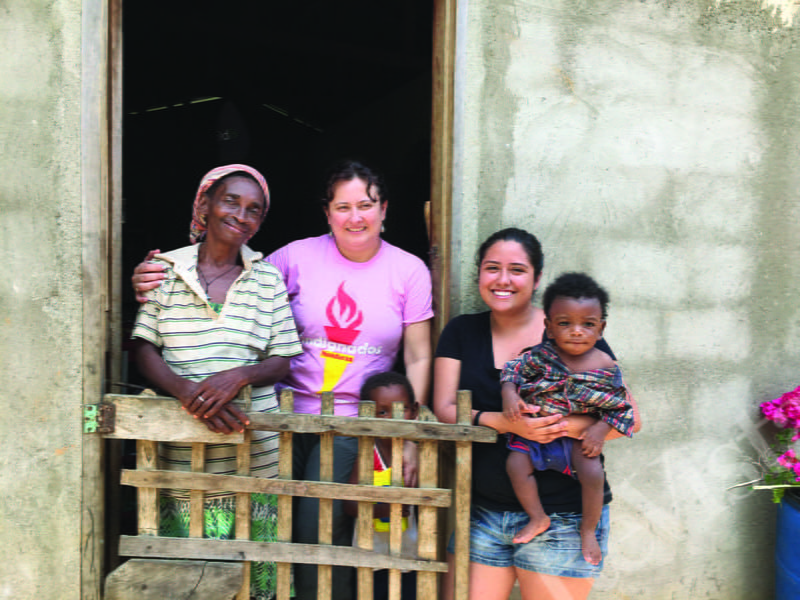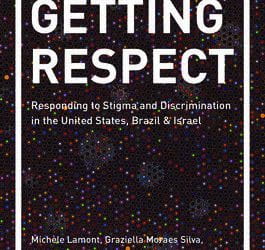Fighting Displacement
The Popular Garifuna Hospital in Honduras
The lonely road leading to the community of Ciriboya, in the municipality of Iriona, Colón, is one of the poorly maintained routes of more than 45 neglected Garifuna communities throughout the north coast of Honduras. Dirt paths with deep potholes lead to dwellings that lack electricity and potable water. The region’s poor infrastructure is a consequence of historical exclusion and institutional discrimination against the Garifuna people. However, on the outskirts of Ciriboya, a bustling yellow two-story building—the Popular Garifuna Hospital—is a place of hope, change and safety for Garifuna communities that are under constant threat of displacement from their land: developers seek to build tourist destinations; agribusiness seeks to expand the African palm plantations; and young people keep leaving by constant (im)migration to nearby cities and the United States to find work, access to education and adequate healthcare. Limited access to healthcare has left the community members plagued by common preventable illnesses.
The Garifuna people are an Afro-indigenous community residing on the circum-Caribbean of Central America. They originally arrived in Honduras in 1797 after being deported by the British from the island of St. Vincent to quell their revolt on the island. Once in Roatan, Honduras, the Garifuna settled in small villages throughout the north coast, such as coastal Ciriboya, where they still maintain their language, cultural practices and spiritual beliefs. Ciriboya is a small hamlet nestled between rivers and the Caribbean Sea in the easternmost part of Colón, where most community members live off the sea by fishing and off the land, by cultivating plaintains and manioc (a tuber used to make cassave, a staple of Garifuna diet.
The Popular Garifuna Hospital was built by the community for the community. The Garifuna community, and especially its women leaders, have worked tirelessly to address the medical needs of people in various villages. Their efforts range from finding solutions to the limited access to healthcare in the poorest communities of northern Honduras, to creating the blueprints of the hospital, to mixing cement, laying brick and finding sufficient funding to serve every patient that comes through the doors for free, and in a culturally appropriate manner. Many of the hospital’s doctors are Garifuna themselves, trained at Cuba’s Latin American Medical School (ELAM). Stories of community members shed light on their healthcare system, the role of poverty in limiting access to healthcare, and the importance of the Popular Garifuna Hospital and the Garifuna doctors.
The first class of Garifuna doctors to graduate from the ELAM collaborated with the local patronatos (elected officials in local towns), OFRANEH (an organization focused on the protection of ancestral lands) and women’s collectives such as the Single Mothers Association and the Auxiliary Nurses Association. Strong women leaders, including Miriam Miranda of OFRANEH, Digna Bernárdez Sambula and Mirna Ruiz, and many community members worked on the development of a healthcare plan for the communities, creating a foundation, Luagu Hatuadi Waduheñu (For the health of our people). The foundation prioritized finding solutions to inadequate healthcare for the region’s Afro-indigenous and indigenous communities and in 2007, with community input and women’s leadership, managed to secure 120 scholarships to study at the ELAM. These were for all Hondurans, but also benefited Garifuna students. The foundation was essential to the effort to build the hospital and staff it permanently with Garifuna and indigenous doctors and Garifuna-speaking staff. The Honduran Autonomous University (UNAH) had only graduated one Garifuna doctor since 1847; the Cuban program made all the difference.
Women are at the core of the Garifuna cosmovision. Their leadership in the community and within the family structure is critical to the wellbeing of the community. From the mid-20th century and onwards, Garifuna communities have been challenged by a long-standing emigration of male workers from the region in search of work and education, which has upset the social cultural balance and division of labor in the community. As Garifuna men move in a constant cycle of internal and international displacement, women and children stay behind.
The Single Mothers Association, formed to assist its members in vocational training and finding work, was fundamental to the construction of the hospital. Digna Bernárdes Sambula, an auxiliary nurse and self-taught midwife who is the president of the health volunteers and the Single Mothers Association in Ciriboya, remembers that the community turned out en masse to a meeting with Dr. Luther Castillo and other Garifuna ELAM students in a local church to form an executive board for the hospital project “with the strength of the community.” Evangelista López Calderón, the current patronato president member, observed, “because the hospital was built by the community, I joined and learned how to mix cement, and since we were all involved in the creation of the hospital we consider it ours.” This level of participation by the local community has generated collective pride and sense of ownership as well as a collective commitment to sustain the project. But women’s participation was critical. Dr. Suyapa Castillo, an ELAM graduate now working in Honduras, explains, “the Garifuna woman is fundamental; for example, if you come with a mission [or] objective and need the community to participate, the leader has to be, [is going to be] a woman.” Garifuna communities from all over Honduras and the diaspora in the United States have contributed to keeping the hospital open and operational, a testament to Garifuna unity and transnationality, but also to women’s networks.
Challenges to Healthcare in Northeast Honduras
In the easternmost villages, Garifuna people, especially women, children and the elderly, face huge barriers in gaining healthcare access. Dr. Suyapa Castillo tells of her own family experience, “I [have] always wanted to be a doctor. Because I’ve always [noticed the] necessity [of the] people. When I was little, when someone was sick my brother [and family members] had to go to Sangrelaya because it was the only health center that was nearby. Sometimes we would walk and other times we would ask a neighbors to lend us a horse to ride.” Previously, they had relied on traditional medicine and healing methods, passed down through generations, to treat their illnesses. Or they faced culturally incompetent care. The Honduran Ministry of Health does not provide well-funded clinics with a culturally aware staff. The poor are forced to travel very far to access public hospitals and facilities. Transportation is limited between the villages, and the nearest city, with one bus running out and another coming in, is a 13-hour bus ride from Ciriboya. Bernárdez Sambula also remembers that before the hospital was built, Garifuna people were forced to travel many hours by foot or horseback to see a doctor. Many community members report experiencing discrimination in treatment by non-Garifuna medical staff in public hospitals, who did not want to touch them because they were black. The other option, of visiting a doctor, was expensive. Community members went only when absolutely necessary, which meant people sought healthcare when they were walking a fine line between life and death.
The Centers for Disease Control and Prevention list perinatal conditions as one of the top causes of death in Honduras. Crucial prenatal care and ultrasound tests were not readily available to women in rural areas. According to local midwives like Bernárdez Sambula, most Garifuna women also prefer home births with traditional midwives, but if a birth was going to be complicated, the midwife would understandably advise going to nearest hospital because of the risk of death to both mother and child. When complications arose during childbirth, women would have to be taken there by hammock, sometimes up to 14 hours away.
The lack of state investment in the infrastructure as well as racism and anti-bilingualism in schools has led many Garifuna community members to migrate to larger cities and then to the United States. Most jobs are on African palm plantations, which require few workers and provide poor welfare for workers and their families, as they are not unionized, nor does the business give back to the local communities. Migration is often blamed for increases in HIV/AIDS rates, often associating Garifuna communities with the disease. Although both popular media and some scientific papers report a high level of HIV/AIDS for which there is often NGO funding, no scientific longitudinal study exists to determine its prevalence. At the same time the Garifuna community has a larger prevalence of upper respiratory illnesses related to cooking in smoky wooden stoves, as well as back problems from carrying large loads with firewood and vegetables from the fields. Water-borne illnesses such as diarrhea are common because of the lack of potable water. Preventable diseases have been overlooked, unfunded and often untreated.
An Alternative Model
The Popular Garifuna Hospital represents an alternative model of free preventative primary care by addressing preventable diseases at no cost to the patient: diabetes, high blood pressure, high cholesterol, diarrhea, respiratory illnesses and diseases related to poor water systems. This alternative model of healthcare is inspired by Cuba’s model of healthcare yet tailored to the specificity of Garifuna communities and the region. Now, local Garifuna and Cuban doctors who understand the community engage with its members to implement solutions and creative ways to access clean water and purify it by boiling it. The doctors follow up with home visits.
The Popular Garifuna Hospital also provides a safe place for women to give birth. With an observation room and ob-gyn consult, the hospital is key in bridging the gap between medical concerns and access to culturally appropiate healthcare. Women are able to receive prenatal care, including ultrasounds and other screenings, as well as postpartum care and care for their newborn. The hospital also provides healthcare, dental care and medication at no cost to the community members, and this year a new surgical unit was opened to provide free surgery.
Census-taking provides doctors with information about family members’ medical histories and health needs, including information about living conditions, nutritional challenges and water availability for each household. ELAM Garifuna medical students participate in these census brigades during their breaks, and Cuban doctors rotating in the hospital and other communities keep up the census work during the school year. In this way, community members receive medical follow-up without the elderly or infirm having to walk very far to the hospital. One doctor explained how she and her colleagues undertook the process of completing the census: “We plan out who is going to visit whom, and since not everything is nearby, we plan who is close to whom, so that we can do the visits, and whom we need to visit [follow up on]. We check how many hypertensives there are, how many kids are nearby that I need to visit. I plan the census accordingly so that I can also do my family visits.”
This healthcare model is also culturally appropriate, since doctors observe and respect traditional Garifuna medicine and spiritual practices. One Cuban doctor commented, “the dentist and I both have master’s degrees in traditional medicine and we use it a lot. Sometimes we have the problem of not knowing what the herb is called here but if I show it to them [or they show it to me], that breaks the barrier. Here they use traditional medicine a lot, and for years they have cured themselves with this natural medicine.”
The Popular Garifuna Hospital differs from other Honduran hospitals, despite its economic hardships and lack of funding, because its staff is attentive to cultural norms. Its workers take into account community needs and provide screenings that address patients’ behavior and nutrition, respecting cultural practices, saving lives, one household at a time, on a year-round basis.
Women in the Community
In Ciriboya and the nearby community of Iriona Viejo, women run social welfare as much as they run the planting of manioc and plantains for daily sustenance. Many did not have formal schooling beyond a primary education due to the lack of funds. Access to any education in the medical sciences or any other field was nearly impossible for members of an earlier generation unless they moved to the big cities of La Ceiba or Trujillo. Bernárdez Sambula, for example, had to abandon her nursing school studies for lack of money and the need to raise her children and take care of her ailing mother. Although she could not finish nursing school, the training enabled her to serve the community and to become the president of the regional Auxiliary Nurses Association. When she had the opportunity to support the initiative to build the hospital, she committed to it, helping both in the physical labor of building it and as president of the patronato.
Since the 2009 coup d’état in Honduras, when the building was besieged by the military, the hospital has been under threat. The political situation since then has affected healthcare throughout the nation; most affected are the indigenous people, Afrodescendants, and rural communities. To none of them has the current conservative government committed any resources or increased access.
In the face of great hardships and callous neglect, as well as the ever-present danger of losing their lands to African palm growers or eco-tourism developers, Garifuna people, led by powerful women, recognize that working and organizing together can change their reality. The work of the hospital suggests that the solutions to fighting displacement can and must come from within the community, and that nation states have to work with community input and consent.
Winter 2017, Volume XVI, Number 2
Suyapa Portillo is an Assistant Professor of Chicano/a and Latino/a Transnational Studies at Pitzer College. Priscilla Cobian is a Pitzer College alumna, who majored in Sociology and Spanish. Sona Patel is a student of history and anthropology at Pitzer College. Luther Castillo Harry is a graduate of the Harvard Kennedy School (MPP) Program and a founding doctor of the Popular Garifuna Hospital.
Related Articles
Colombia’s Other Displacements
Of course, I knew about Colombia’s sad statistics on displacement, with the highest numbers in Latin America and vying with those of war-torn countries like Sudan and…
Getting Respect
When I first arrived in Brazil in the 1980s, I quickly learned that race in Brazil was not important there. The country that once had by far the largest slave population in the…
Ana Tijoux’s Radical Crossing of Borders
This summer, I was an intern in Santiago’s Museum of Memory and Human Rights, the museum dedicated to the victims of Pinochet’s dictatorship. Since I was in Chile…





